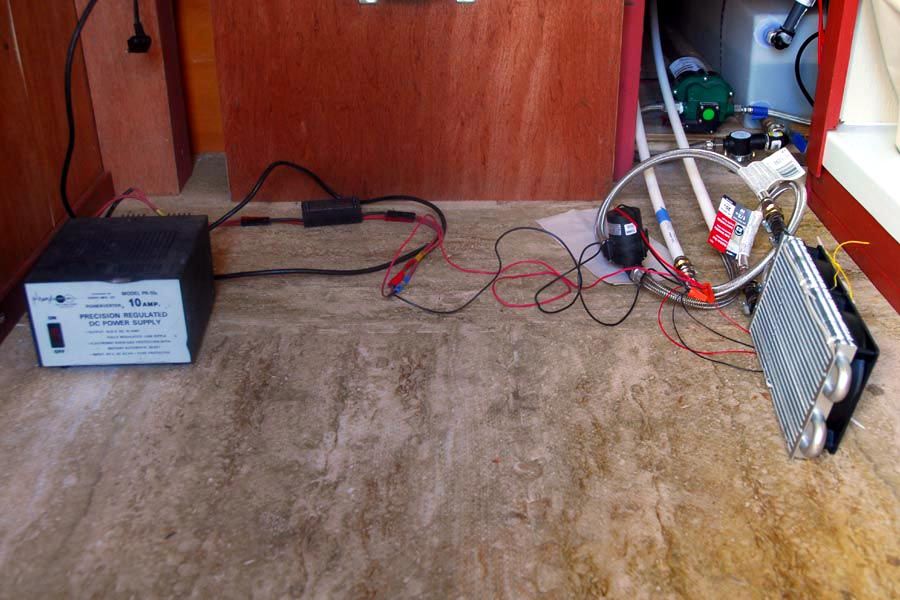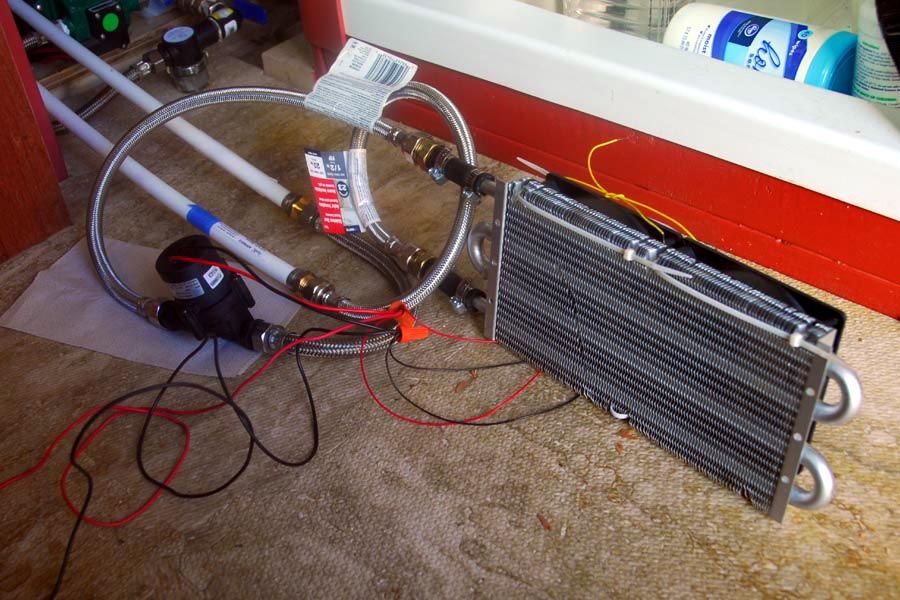|
| Author |
Message |
MtnDon
Member
|
# Posted: 28 Jan 2015 08:39pm - Edited by: MtnDon
Reply
Many months ago I mentioned that I was doing a project to convert a cargo trailer into a travel trailer. There was a link to it but that got removed. Anyhow, the trailer was completed in early summer 2014 and has had several trips. It is rated a success. However, it did have one notable short coming. I did not build it with a heater or furnace. In part that was due to time constraints.
I have now got a trial underway. For the heat source we are using the hot water from the RV water heater. I though I'd post this as some of the small cabins here have small water heaters.
The trailer has a 6 gallon Suburban brand water heater, one with a pilot light, not the direct ignition one. Either would work.
Today I finally put the idea into some action. I did some rough plumbing. I tapped into the hot line near the water heater outlet. I also tapped into the cold line very close to the water heater cold inlet.
This is a very basic hookup for the first performance test.... The general layout...

I'm running the tests off my 12 VDC power supply with a watt meter. The two white PEX pipes in the upper right come from connections near the water heater hot and cold connections. Blue tape = cold(er) pipe.
A closer up view of the heater and pump...

The hot pipe connects to the inlet side of the pump. The pump is rated at a flow rate of approximately 3 gal/minute. The finned radiator is a transmission cooler, approximately 6 x 12 inches. It has never bee used for oil or anything other than water. (It is the unit I tried in the heater experiment in the cabin a few years ago) The fans are secured with wire ties; quick and easy for testing. They are oriented to blow air through the fins. At present the pump and fans are wired up to run continuously. At present I do not have a temperature controller or thermostat. That will come if this first stage is deemed a success.
Close up shot of the watt meter reading. This was taken moments after turning the power on. Taking a photo of the display is a tad difficult and needed some manipulation...

With pump and fans running the amp draw is at 0.67 with the watts at 8.7 (at 13.3 volts).
The plan is to run all night and see how many watt-hours are used and what the temperature inside the trailer is in the morning. The water heater thermostat is set at medium. The test started late this afternoon (4:30 PM MST) with the exterior temperature at 58 F and dropping. The trailer interior was at 70 F. The overnight low is forecast to be 37 F.
The fans....
http://www.amazon.com/gp/product/B004SBYQE8/ref=oh_aui_detailpage_o05_s00?ie=UTF8&psc =1
The pump....
http://www.ebay.com/itm/New-Top-DC-12V-12L-M-3M-15W-Panel-Circulation-Solar-Powered-H ot-Water-Pump-/391022362224?pt=LH_DefaultDomain_0&hash=item5b0abfbe70
The hoses are faucet connection hoses with 1/2" pipe thread fittings.
The fans are rated at 19.1 dB per fan. The pump is rated at <45 dB.
|
|
Just
Member
|
# Posted: 28 Jan 2015 10:12pm
Reply
We have our own Edison ,good job Don .
|
|
fasenuff
Member
|
# Posted: 28 Jan 2015 11:01pm
Reply
I am curious to see how much propane you use for the heat you get..
|
|
neb
Member
|
# Posted: 28 Jan 2015 11:09pm
Reply
Very interesting! Good job.
|
|
Wilbour
Member
|
# Posted: 29 Jan 2015 08:30am
Reply
Quoting: MtnDon Many months ago I mentioned that I was doing a project to convert a cargo trailer into a travel trailer. There was a link to it but that got removed.
The Admin. keeps all entries to a narrow scope. Most of the time this works well, but occasionally it will weed out articles that have tangents that tie well with Small Cabin topics.
MtnDon:
Looking forward to seeing your results published
|
|
soundandfurycabin
Member
|
# Posted: 29 Jan 2015 05:30pm
Reply
Brilliant idea...if it works out I'll seriously consider copying it. For permanent installation though, the pump will likely live longer if installed on the coolest part of the loop.
|
|
toyota_mdt_tech
Member
|
# Posted: 29 Jan 2015 07:52pm - Edited by: toyota_mdt_tech
Reply
Dont, I bought this for mine (I did something close to what you did, it was a race support trailer (motocross) and we slept in it.
http://ducktec.com/itm00099.html
I remember paying only $399 for the NT20SE at the time (2004) its an electronic ignition, no pilot.
I also added AC too. But did remove it last year, sold it and installed just an extra roof vent.
The NT20SE uses 2.8 amps and is thermostatically controlled. Its plumbed with 3/8" copper gas line.
I have a webpage I made for the build. I had too many questions from people and just made a link instead. I kept it a "cargo trailer", but made it suitable for overnight stays.
|
|
MtnDon
Member
|
# Posted: 29 Jan 2015 08:23pm - Edited by: MtnDon
Reply
Unstated was that a big part of the reason for exploring this avenue is space. Or lack of space. RV furnaces like that take up space I don't want to give up, or space that simply is not there or has been used by other stuff. A big issue is the need to have the rear end of the furnace abutt an exterior wall for the intake and exhaust. We don't have a space that would be feasible. Easily.
My preferred solution is ideal in all respects, save cost. $700 or so. A Propex heater could be located hidden under the bed. Ducts to distribute heat are 2" hose IIRC. It's a direct vent and is a wonder of efficiency; 93% or thereabouts.
So I do appreciate the suggestion, but I really don't want to go in that direction. Last nights simple test indicates this should be a very viable solution for the three season camping we do.
I post it as it might be a solution someone can use to prevent freezing in a small cabin.
|
|
|
creeky
Member
|
# Posted: 31 Jan 2015 05:35pm
Reply
just saw this. nice post.
I've always believed there are no "best" solutions for small cabins. Instead there are many and varied hybrid solutions very much location / resource dependent solutions.
so: you could do this for way less money. salvage etc. and in my climate: -24 right now, that little heater is something in the wind.
but what a great idea. and for me. adaptable as a battery warmer. i like it as a floor heater too.
thx. mtndon. what a great adaptation of a hot water source that is readily available ... both new and second/third/salvage.
|
|
MtnDon
Member
|
# Posted: 7 Feb 2015 12:36pm - Edited by: MtnDon
Reply
Latest data...
Water heater burner on to heat water to 136 degrees then turned off.
Water pump and fans turned on and left to run to stabilize. (two 45 CFM fans)
Measured temperature every minute until temperature began to fall.
Started timing.
Trailer interior at 46 F.
Hot line (surface of PEX pipe) from water heater measured just before radiator @ 131 F.
I left the trailer and let the pump & fans run for 15 minutes.
Hot line then measured @ 119 F, a difference of 12 degrees
Water tank volume is 6 gallons. I don't know how accurate that is or if the volume takes into account the space occupied by the burner heat exchange tube. 6 gallons @ 8.34 pounds per gallon = 50 pounds. I reduced that to 48 lbs. to help compensate for the burner tube, if necessary.
48 pounds with a 12 degree temperature drop, 48 lbs x 12 degrees = 576 BTU's.
(temperature change of 1 degree F on 1 lb.of water = 1 BTU by definition)
576 BTU per 15 minutes = 2304 BTU/hour, call it 2300 BTU/hour. For the curious that converts to 675 watts. Not a high capacity heater for certain, but the trailer is a small enough space and insulated well. The interior volume of the trailer calculates to about 440 cu ft, BTW.
BTW, the interior temperature rose to 50.3 F in the 15 minutes. Call that 4 degrees and that works out to 16 degrees an hour, more or less.
Keep in mind that temperature change slows down as the difference between the hotter and the cooler decreases, so the interior temperature rise will slow down from the initial 4 degrees per 15 minutes. Also the transfer of heat from the radiator to the air will slow down as the interior warms. Slightly compensating will be that the water temperature will return to 131 and even higher when the burner is allowed to be turned back on by the water heater controller.
Next I think will be to change the fans to the higher output 90 CFM and retest tomorrow morning or late tonight. It's too sunny to get any really meaningful data during the day.
|
|
MtnDon
Member
|
# Posted: 8 Feb 2015 11:08am
Reply
New trial this morning; new data
I changed the fans to the twin 90 CFM models.
I repeated the warm up process as done yesterday.
Initial temperature at the pipe = 138 F
After a 15 minute run the temperature measured at the pipe fell to 113 F
Temperature difference = 25 F
48 lbs water x 25 degrees F = 1200 BTU per 15 minutes or 4800 BTU / hour
4800 BTU/hr = 1406 watts, call it 1400 watts.
The increased fan volume makes quite a difference!
I messed up with the before and after interior temperature readings so I do not have that data.  However, that is of minor importance. However, that is of minor importance.
I also measured the temperature at the pipe after 7.5 minutes. At that point it was 119 F, a drop of 19 F. (The second 7.5 minutes saw a drop of only 7 degrees F. This reflects the faster rate of heat transfer that occurs with greater temperature differentials) 48 lbs x 19 degrees F = 912 BTU/hour. If we round that to 900 BTUH and then multiply by 8 we get 7200 BTUH or the equivalent of 2100 watts. That would be more or less what the output would be if the water heater burner was left turned on so as the water temperature dropped the burner would cut back in and bring the water temperature back up. (That water temperature is achievable with the heater control set on high. Depending on the weather or the need to heat quicker/slower the water heater could be used at a lower setting.)
The twin 90 CFM fans are noisier, but still not bad. We use an air filter device at home in the bedroom in part to act as a white noise when one of us goes off to bed earlier than the other. The twin 90 CFM are quieter than that bedroom unit so I don't see any potential issue there. Just in case, though, I am pondering whether or not I should wire the trailer fans up with the PWM speed controller I have. I did re-find it yesterday! And then that raises the question of slowing the pump as well, or not? ???
One more thing, the current draw increased from 0.67 amps to 0.77 amps with the twin 90 CFM fans. (Pump and fans total)
|
|
|

